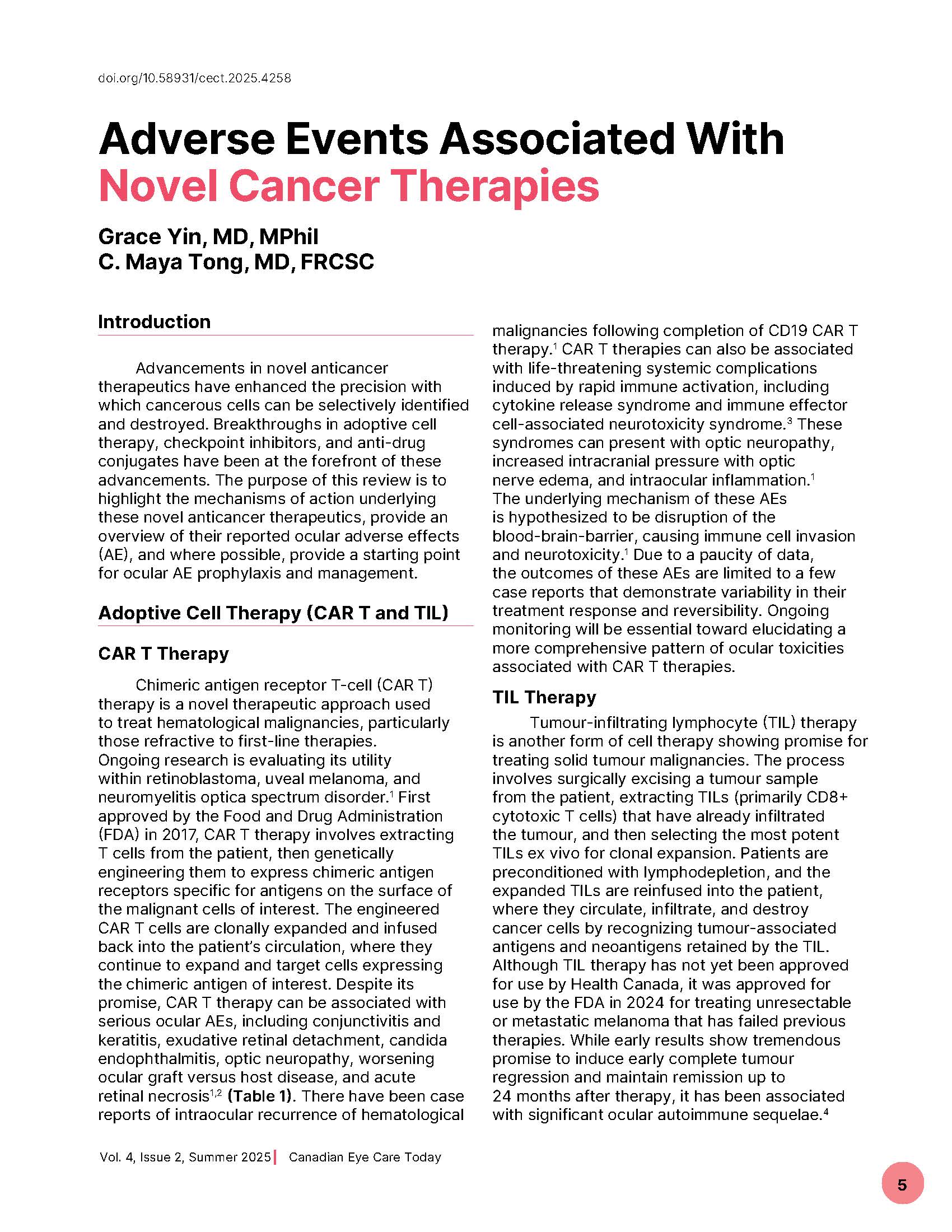Adverse Events Associated With Novel Cancer Therapies
DOI:
https://doi.org/10.58931/cect.2025.4258Abstract
Advancements in novel anticancer therapeutics have enhanced the precision with which cancerous cells can be selectively identified and destroyed. Breakthroughs in adoptive cell therapy, checkpoint inhibitors, and anti-drug conjugates have been at the forefront of these advancements. The purpose of this review is to highlight the mechanisms of action underlying these novel anticancer therapeutics, provide an overview of their reported ocular adverse effects (AE), and where possible, provide a starting point for ocular AE prophylaxis and management.
References
Sarwar S, Riaz U, Ali A, Kailash SJ. Adverse events associated with chimeric antigen receptor T-cell therapy in ophthalmology: a narrative review. Ann Med Surg (Lond). 2024;86(7):4035–4041. doi:10.1097/ms9.0000000000002188 DOI: https://doi.org/10.1097/MS9.0000000000002188
Frey C, Cherniawsky H, Etminan M. Ocular adverse events following CAR-T cell therapy: a pharmacovigilance study and systematic review. Eur J Haematol. 2024;113(1):66–71. doi:10.1111/ejh.14208 DOI: https://doi.org/10.1111/ejh.14208
Morris EC, Neelapu SS, Giavridis T, Sadelain M. Cytokine release syndrome and associated neurotoxicity in cancer immunotherapy. Nat Rev Immunol. 2022;22(2):85–96. doi:10.1038/s41577-021-00547-6 DOI: https://doi.org/10.1038/s41577-021-00547-6
Betof Warner A, Corrie PG, Hamid O. Tumor-infiltrating lymphocyte therapy in melanoma: facts to the future. Clin Cancer Res. 2023;29(10):1835–1854. doi:10.1158/1078-0432.Ccr-22-1922 DOI: https://doi.org/10.1158/1078-0432.CCR-22-1922
Yeh S, Karne NK, Kerkar SP, Heller CK, Palmer DC, Johnson LA, et al. Ocular and systemic autoimmunity after successful tumor-infiltrating lymphocyte immunotherapy for recurrent, metastatic melanoma. Ophthalmology. 2009;116(5):981–989.e981. doi:10.1016/j.ophtha.2008.12.004 DOI: https://doi.org/10.1016/j.ophtha.2008.12.004
Dalvin LA, Shields CL, Orloff M, Sato T, Shields JA. CHECKPOINT INHIBITOR IMMUNE THERAPY: systemic indications and ophthalmic side effects. Retina. 2018;38(6):1063–1078. doi:10.1097/iae.0000000000002181 DOI: https://doi.org/10.1097/IAE.0000000000002181
Zhou YW, Xu Q, Wang Y, Xia RL, Liu JY, Ma XL. Immune checkpoint inhibitor-associated ophthalmic adverse events: current understanding of its mechanisms, diagnosis, and management. Int J Ophthalmol. 2022;15(4):646–656. doi:10.18240/ijo.2022.04.19 DOI: https://doi.org/10.18240/ijo.2022.04.19
Martens A, Schauwvlieghe PP, Madoe A, Casteels I, Aspeslagh S. Ocular adverse events associated with immune checkpoint inhibitors, a scoping review. J Ophthalmic Inflamm Infect. 2023;13(1):5. doi:10.1186/s12348-022-00321-2 DOI: https://doi.org/10.1186/s12348-022-00321-2
Eaton JS, Miller PE, Mannis MJ, Murphy CJ. Ocular adverse events associated with antibody-drug conjugates in human clinical trials. J Ocul Pharmacol Ther. 2015;31(10):589–604. doi:10.1089/jop.2015.0064 DOI: https://doi.org/10.1089/jop.2015.0064
Dy GK, Farooq AV, Kang JJ. Ocular adverse events associated with antibody-drug conjugates for cancer: evidence and management strategies. Oncologist. 2024;29(11):e1435–e1451. doi:10.1093/oncolo/oyae177 DOI: https://doi.org/10.1093/oncolo/oyae177
Méndez-Martínez S, Calvo P, Ruiz-Moreno O, Pardiñas Barón N, Leciñena Bueno J, Del Rocío G, et al. Ocular adverse events associated with MEK inhibitors. National Library of Medicine; 2019 [cited 30 June 2025]. Available from: www.clinicaltrials.gov. DOI: https://doi.org/10.1097/IAE.0000000000002451
Liu CY, Francis JH, Brodie SE, Marr B, Pulido JS, Marmor MF, et al. Retinal toxicities of cancer therapy drugs: biologics, small molecule inhibitors, and chemotherapies. Retina. 2014;34(7):1261–1280. doi:10.1097/iae.0000000000000242 DOI: https://doi.org/10.1097/IAE.0000000000000242
Castillejo Becerra CM, Smith WM, Dalvin LA. Ophthalmic adverse effects of BRAF inhibitors. Eur J Ophthalmol. 2022:11206721221132872. doi:10.1177/11206721221132872 DOI: https://doi.org/10.1177/11206721221132872
Choe CH, McArthur GA, Caro I, Kempen JH, Amaravadi RK. Ocular toxicity in BRAF mutant cutaneous melanoma patients treated with vemurafenib. Am J Ophthalmol. 2014;158(4):831–837.e832. doi:10.1016/j.ajo.2014.07.003 DOI: https://doi.org/10.1016/j.ajo.2014.07.003
Basti S. Ocular toxicities of epidermal growth factor receptor inhibitors and their management. Cancer Nurs. 2007;30(4 Suppl 1):S10–16. doi:10.1097/01.Ncc.0000281759.23823.82 DOI: https://doi.org/10.1097/01.NCC.0000281759.23823.82
Shin E, Lim DH, Han J, Nam DH, Park K, Ahn MJ, et al. Markedly increased ocular side effect causing severe vision deterioration after chemotherapy using new or investigational epidermal or fibroblast growth factor receptor inhibitors. BMC Ophthalmol. 2020;20(1):19. doi:10.1186/s12886-019-1285-9 DOI: https://doi.org/10.1186/s12886-019-1285-9
Fu C, Gombos DS, Lee J, George GC, Hess K, Whyte A, et al. Ocular toxicities associated with targeted anticancer agents: an analysis of clinical data with management suggestions. Oncotarget. 2017;8(35):58709–58727. doi:10.18632/oncotarget.17634 DOI: https://doi.org/10.18632/oncotarget.17634
Chelala E, Hoyek S, Arej N, Kattan J, Kourie HR, Baakliny J, et al. Ocular and orbital side effects of ALK inhibitors: a review article. Future Oncol. 2019;15(16):1939–1945. doi:10.2217/fon-2018-0608 DOI: https://doi.org/10.2217/fon-2018-0608

Downloads
Published
How to Cite
Issue
Section
License
Copyright (c) 2025 Canadian Eye Care Today

This work is licensed under a Creative Commons Attribution-NonCommercial-NoDerivatives 4.0 International License.
